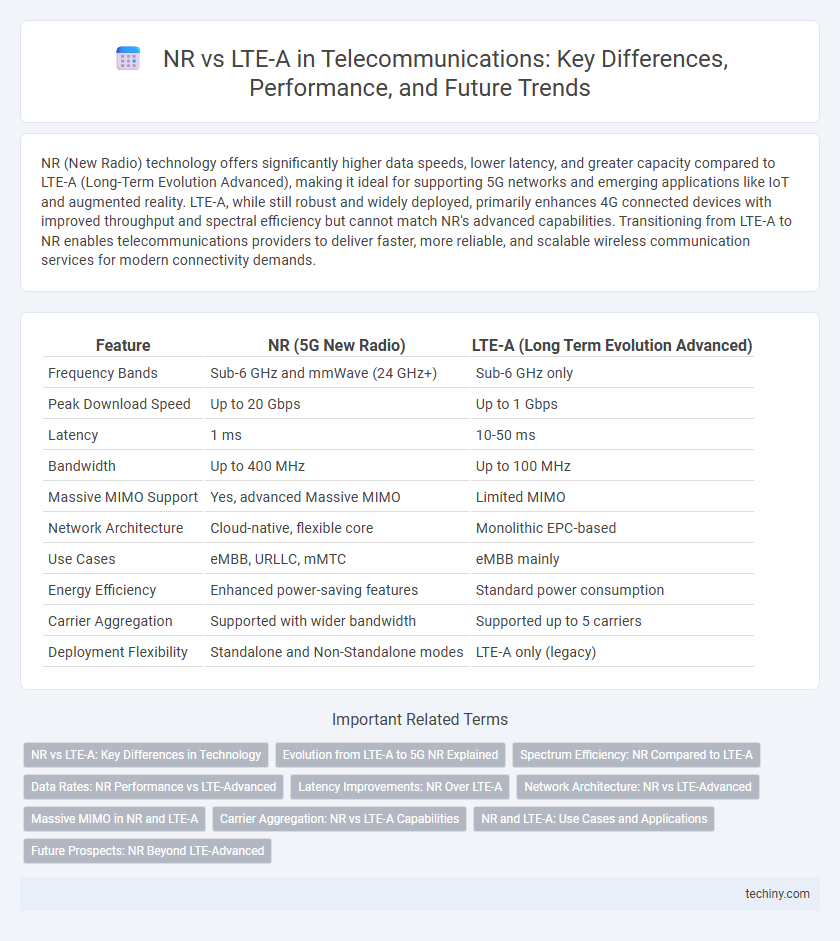NR (New Radio) technology offers significantly higher data speeds, lower latency, and greater capacity compared to LTE-A (Long-Term Evolution Advanced), making it ideal for supporting 5G networks and emerging applications like IoT and augmented reality. LTE-A, while still robust and widely deployed, primarily enhances 4G connected devices with improved throughput and spectral efficiency but cannot match NR's advanced capabilities. Transitioning from LTE-A to NR enables telecommunications providers to deliver faster, more reliable, and scalable wireless communication services for modern connectivity demands.
Table of Comparison
| Feature | NR (5G New Radio) | LTE-A (Long Term Evolution Advanced) |
|---|---|---|
| Frequency Bands | Sub-6 GHz and mmWave (24 GHz+) | Sub-6 GHz only |
| Peak Download Speed | Up to 20 Gbps | Up to 1 Gbps |
| Latency | 1 ms | 10-50 ms |
| Bandwidth | Up to 400 MHz | Up to 100 MHz |
| Massive MIMO Support | Yes, advanced Massive MIMO | Limited MIMO |
| Network Architecture | Cloud-native, flexible core | Monolithic EPC-based |
| Use Cases | eMBB, URLLC, mMTC | eMBB mainly |
| Energy Efficiency | Enhanced power-saving features | Standard power consumption |
| Carrier Aggregation | Supported with wider bandwidth | Supported up to 5 carriers |
| Deployment Flexibility | Standalone and Non-Standalone modes | LTE-A only (legacy) |
NR vs LTE-A: Key Differences in Technology
NR (New Radio) introduces a flexible frame structure and broader frequency bands compared to LTE-A, enabling higher data rates and lower latency essential for 5G applications. LTE-A (LTE-Advanced) relies on carrier aggregation and improved MIMO but remains limited in spectrum efficiency and bandwidth scalability relative to NR. NR supports advanced features like dynamic spectrum sharing and massive MIMO, providing superior network capacity and enhanced user experience over LTE-A.
Evolution from LTE-A to 5G NR Explained
5G NR (New Radio) represents a significant evolution from LTE-A (Long-Term Evolution Advanced) by supporting higher bandwidths, lower latency, and enhanced spectral efficiency through advanced MIMO and flexible numerology. NR introduces a unified framework across both sub-6 GHz and millimeter-wave frequencies, enabling ultra-reliable low-latency communications (URLLC) and massive machine-type communications (mMTC) that LTE-A cannot fully achieve. The transition from LTE-A to 5G NR leverages network slicing and dynamic spectrum sharing to optimize network resources and support diverse use cases from enhanced mobile broadband (eMBB) to industrial IoT.
Spectrum Efficiency: NR Compared to LTE-A
New Radio (NR) technology achieves significantly higher spectrum efficiency than LTE-Advanced (LTE-A) by utilizing advanced modulation schemes such as 256-QAM and scalable numerology, which optimize bandwidth usage. NR supports massive MIMO and beamforming techniques that enhance signal quality and increase data throughput per Hz of spectrum. These innovations result in improved network capacity and user experience, particularly in high-density urban environments.
Data Rates: NR Performance vs LTE-Advanced
NR (New Radio) significantly outperforms LTE-Advanced in data rates, offering peak download speeds exceeding 20 Gbps compared to LTE-A's maximum of around 3 Gbps. Enhanced spectrum efficiency, massive MIMO, and higher frequency bands in NR enable ultra-high throughput and low latency connectivity. LTE-A relies on carrier aggregation and advanced modulation schemes but cannot match the multi-gigabit capacity enabled by 5G NR technology.
Latency Improvements: NR Over LTE-A
NR (New Radio) significantly reduces latency compared to LTE-A by utilizing advanced features such as mini-slot scheduling and flexible numerology, enabling ultra-reliable low-latency communications (URLLC). LTE-A typically achieves latency around 10-15 milliseconds, whereas NR can lower this to as little as 1 millisecond, facilitating real-time applications like autonomous driving and remote surgery. These latency improvements stem from NR's ability to support faster uplink and downlink transmissions, enhancing overall network responsiveness and efficiency.
Network Architecture: NR vs LTE-Advanced
NR (New Radio) features a flexible, service-based architecture with a centralized control plane and distributed user plane, enabling dynamic network slicing and enhanced scalability. LTE-Advanced employs a hierarchical EPC (Evolved Packet Core) architecture with separated control and user planes, relying on static bearer management, which limits adaptability. NR's modular design supports ultra-low latency and massive IoT connectivity, surpassing LTE-A's traditional architecture constraints.
Massive MIMO in NR and LTE-A
NR (New Radio) leverages Massive MIMO technology with advanced beamforming and higher antenna counts, significantly improving spectral efficiency and network capacity compared to LTE-A. While LTE-A supports MIMO configurations up to 8x8, NR expands this to 64x64 or even 256x256 antenna arrays, enabling better spatial multiplexing and reduced interference. This enhancement in NR's Massive MIMO facilitates ultra-reliable low-latency communications (URLLC) and supports diverse 5G use cases beyond LTE-A capabilities.
Carrier Aggregation: NR vs LTE-A Capabilities
NR (New Radio) supports dynamic carrier aggregation with scalable bandwidth parts allowing seamless aggregation across both licensed and unlicensed spectra, significantly enhancing network throughput and spectral efficiency. LTE-A (Long-Term Evolution Advanced) typically aggregates up to five component carriers with fixed bandwidth, limiting flexibility compared to NR's broader frequency range and millisecond-level beam management. NR's advanced carrier aggregation capabilities facilitate ultra-reliable low latency communications (URLLC) and massive machine-type communications (mMTC) beyond LTE-A's capacity.
NR and LTE-A: Use Cases and Applications
NR (New Radio) enhances telecommunications by supporting diverse use cases such as enhanced mobile broadband (eMBB), ultra-reliable low-latency communications (URLLC), and massive machine-type communications (mMTC), enabling applications like smart cities, autonomous vehicles, and augmented reality. LTE-A (Long Term Evolution Advanced) primarily targets improved mobile broadband with features like carrier aggregation and higher spectral efficiency, making it suitable for high-speed internet access and video streaming. NR's flexible architecture and low latency capabilities expand the scope of applications beyond LTE-A's focus, driving innovation in 5G-enabled industries and IoT ecosystems.
Future Prospects: NR Beyond LTE-Advanced
NR (New Radio) surpasses LTE-Advanced by supporting higher data rates, ultra-low latency, and massive connectivity needed for 5G applications. Its flexible numerology and scalable bandwidth enable deployment across diverse frequency bands, enhancing network efficiency and capacity beyond LTE-A limits. Future prospects include integration with AI-driven network management and advanced IoT ecosystems, positioning NR as the cornerstone of next-generation telecommunications infrastructure.
NR vs LTE-A Infographic

 techiny.com
techiny.com